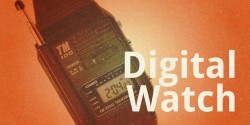Yesterday was the 20th birthday of the MP3. As historian Brian McCullough tells it on his Internet History Podcast, on July 14, 1995 an email made the rounds at the Fraunhofer Institute for Integrated Circuits in Germany declaring, “everyone voted for .mp3 as extension for ISO MPEG Audio Layer 3!” At that moment the files containing compressed audio that would go on to utterly change music gained their name.
In the most recent episode of his fantastic show, McCullough talks with Karlheinz Brandenburg, whose PhD research into perceptual audio encoding birthed the MP3, although Brandenburg is reluctant to accept the title of “father” of the format. MP3 had two contemporaneous competitors in the nascent audio compression world of the mid–90s, and ultimately became predominant because the Fraunhofer Institute where Brandenburg worked and which owned the patent to the underlying technology first allowed the format to propagate in freely distributed shareware software. This catalyzed its adoption by hobbyists and programmers, leading to MP3 being supported by major software companies, like Microsoft, which paid royalties for every copy of Windows that could play back .mp3 files.
While I’ve recently advocated for internet radio to move on from MP3 encoding, I still have enormous respect for the format and the revolution in digital audio unleashed by its invention and adoption. Brandenburg notes that in the mid–90s it was a major feat of programming prowess to create software that could actually play back an MP3 file in real time on the computers of the day. The computing power necessary to handle MP3s was one reason that a competing codec–MPEG 1 Layer 2, often known as .mp2–was adopted for many commercial digital audio applications born in the 1990s, including DVDs and the Public Radio Satellite System, since .mp2 required less horsepower to play back in real time.
I can remember downloading my first .mp2 and .mp3 files in 1996, along with the software to play them, all over a 56kbps modem. I was impressed that a three-minute track stereo track encoded in .mp2 required just less than ten minutes to download, and sounded really good.
Unfortunately for me, my poor one year-old Windows 95 PC was brought to its knees trying to play the .mp3, resulting in choppy audio that eventually just crashed the player app. I had to actually convert the .mp3 to an uncompressed .wav file–a process that also required several minutes–to hear what was encoded in that mysterious file. Then, just a few years and one new PC later, I, and thousands of other internet users, would be actively trading and downloading MP3 files to play back, without our computers even breaking a sweat.
Despite strong competition from the likes of Real Audio and Windows Media Audio, MP3 ended up victorious as the default standard for internet radio, too. Though well into the first decade of the 21st century it was still often necessary to have multiple player apps installed in order to enjoy the full range of stations on the ’net, by the end of that decade that nonsense was mostly eschewed in favor of MP3, and its more sophisticated successor, AAC. Though MP3 didn’t necessarily sound any better than its competitors (and it sure didn’t sound worse), the format was less proprietary and comparatively easier to license, making for a wider variety of servers and players that weren’t tied to a particular operating system or technology.
I also learned in the Internet History Podcast that Brandenburg, the MP3 daddy, also shares responsibility for AAC. That fact makes me feel a little better about dissing the MP3 in favor of the better-sounding AAC. Since they both come from the same family tree, preferring AAC is like choosing an iPhone 6 over an iPhone 3g–the technological superiority is hard to argue against.
Despite the flaws of lossy compression like MP3, this technology made possible internet radio, podcasting, internet calling like Skype, satellite radio, and just about every application that transmits audio over a digital connection. Although today’s broadband connections permit us to receive lossless digital audio, which I prefer, lossy compressed audio still has a place where bandwidth and storage are still at a premium. Don’t get me wrong–I am not against MP3, AAC or other lossy compression formats. I just see no benefit in using them in situations where the constraints that birthed them are no longer relevant.
To learn even more about the MP3 and its place in twentieth century communication history, I highly recommend Jonathan Sterne’s book MP3: The Meaning of a Format. Although an academic tome, Sterne’s prose is approachable and clear–it doesn’t require a technical background to understand at all.
Happy Birthday MP3!



